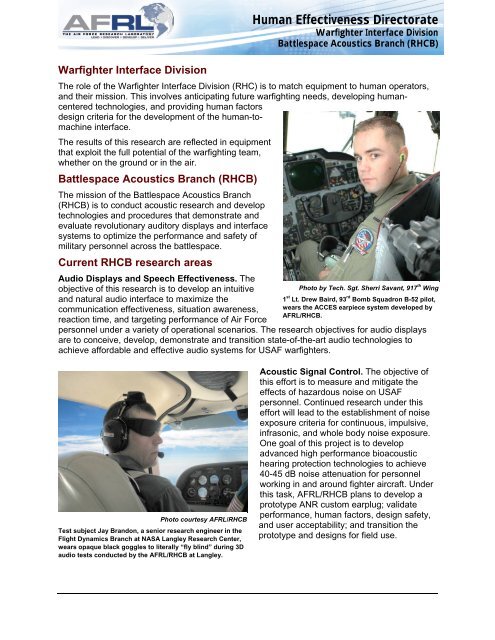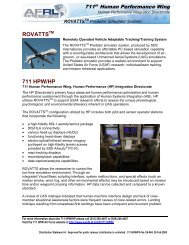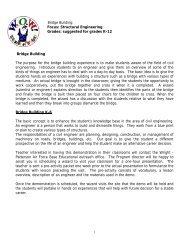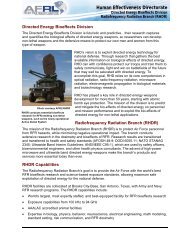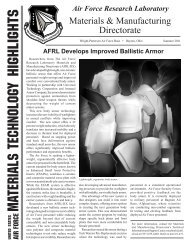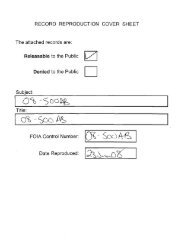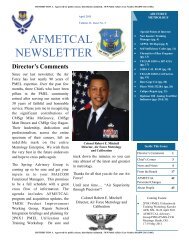Battlespace Acoustics - Wright-Patterson Air Force Base
Battlespace Acoustics - Wright-Patterson Air Force Base
Battlespace Acoustics - Wright-Patterson Air Force Base
You also want an ePaper? Increase the reach of your titles
YUMPU automatically turns print PDFs into web optimized ePapers that Google loves.
Warfighter Interface Division<br />
Human Effectiveness Directorate<br />
Warfighter Interface Division<br />
<strong>Battlespace</strong> <strong>Acoustics</strong> Branch (RHCB)<br />
The role of the Warfighter Interface Division (RHC) is to match equipment to human operators,<br />
and their mission. This involves anticipating future warfighting needs, developing humancentered<br />
technologies, and providing human factors<br />
design criteria for the development of the human-tomachine<br />
interface.<br />
The results of this research are reflected in equipment<br />
that exploit the full potential of the warfighting team,<br />
whether on the ground or in the air.<br />
<strong>Battlespace</strong> <strong>Acoustics</strong> Branch (RHCB)<br />
The mission of the <strong>Battlespace</strong> <strong>Acoustics</strong> Branch<br />
(RHCB) is to conduct acoustic research and develop<br />
technologies and procedures that demonstrate and<br />
evaluate revolutionary auditory displays and interface<br />
systems to optimize the performance and safety of<br />
military personnel across the battlespace.<br />
Current RHCB research areas<br />
Audio Displays and Speech Effectiveness. The<br />
objective of this research is to develop an intuitive<br />
and natural audio interface to maximize the<br />
communication effectiveness, situation awareness,<br />
reaction time, and targeting performance of <strong>Air</strong> <strong>Force</strong><br />
Photo by Tech. Sgt. Sherri Savant, 917 th Wing<br />
1 st Lt. Drew Baird, 93 rd Bomb Squadron B-52 pilot,<br />
wears the ACCES earpiece system developed by<br />
AFRL/RHCB.<br />
personnel under a variety of operational scenarios. The research objectives for audio displays<br />
are to conceive, develop, demonstrate and transition state-of-the-art audio technologies to<br />
achieve affordable and effective audio systems for USAF warfighters.<br />
Photo courtesy AFRL/RHCB<br />
Test subject Jay Brandon, a senior research engineer in the<br />
Flight Dynamics Branch at NASA Langley Research Center,<br />
wears opaque black goggles to literally “fly blind” during 3D<br />
audio tests conducted by the AFRL/RHCB at Langley.<br />
Acoustic Signal Control. The objective of<br />
this effort is to measure and mitigate the<br />
effects of hazardous noise on USAF<br />
personnel. Continued research under this<br />
effort will lead to the establishment of noise<br />
exposure criteria for continuous, impulsive,<br />
infrasonic, and whole body noise exposure.<br />
One goal of this project is to develop<br />
advanced high performance bioacoustic<br />
hearing protection technologies to achieve<br />
40-45 dB noise attenuation for personnel<br />
working in and around fighter aircraft. Under<br />
this task, AFRL/RHCB plans to develop a<br />
prototype ANR custom earplug; validate<br />
performance, human factors, design safety,<br />
and user acceptability; and transition the<br />
prototype and designs for field use.
Human Effectiveness Directorate<br />
Warfighter Interface Division<br />
<strong>Battlespace</strong> <strong>Acoustics</strong> Branch (RHCB)<br />
Dynamic Acoustic Modeling & Simulation. The goal of this effort is to accurately<br />
calculate/predict aircraft noise footprints during all aspects of flight accounting for terrain and<br />
weather effects.<br />
Basic and Applied Research in Auditory Perception. Develop descriptive models of auditoryvisual<br />
interaction in complex environments. Determine effect of temporal onset of auditory cue<br />
can reduce response time of visual<br />
stimulus at point of visual fixation.<br />
Determine weighting of auditory<br />
and/or visual distractors on target<br />
acquisition times. Measure the<br />
amount of spatial disparity between<br />
auditory and visual stimuli which<br />
can be tolerated with negligible<br />
effects on performance. Measure<br />
the performance of degraded<br />
spatial auditory cues – ambient<br />
masking noise, missing spectral<br />
cues. Determine the extent of<br />
auditory visual interaction in<br />
dynamic auditory and/or<br />
visual complex environments<br />
with distractors.<br />
Audio Distance Perception. The<br />
goal of this research is to enhance<br />
the capabilities of auditory display<br />
systems by providing robust,<br />
intuitive auditory distance cues<br />
based on the auditory cues that<br />
listeners use to determine the<br />
distances of sound sources in<br />
natural listening environments. One<br />
aspect of this research focuses on<br />
auditory distance cues that are<br />
related to the acoustic properties<br />
of speech.<br />
Photo courtesy AFRL/RHCB<br />
The audio localization facility (ALF) is a 4.26-meter diameter geodesic<br />
sphere located inside a 6.2 x 6.2 x 6.2 meter anechoic chamber. The<br />
sphere contains 277 loudspeakers that present single or multiple sounds<br />
from any location on the sphere.<br />
For more information contact…<br />
AFRL/RHCB<br />
<strong>Wright</strong>-<strong>Patterson</strong> AFB, Ohio 45433<br />
Phone ...... (937) 255-4478<br />
DSN ......... 785-4478


